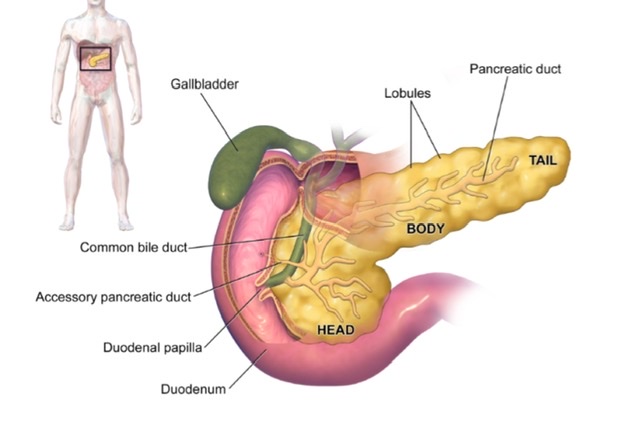
PANCREAS
Q.1 Why pancreas is called a ‘double gland’?
The pancreas is called a double gland because it is partly exocrine and partly endocrine.
Q.2 What are the secretions of the pancreas?
The exocrine part secretes pancreatic juice which has digestive functions. Endocrine part secretes hormones, e.g. insulin, glucagon, etc.
Q.3 At what level the pancreas lie?
The pancreas lies across the posterior abdominal wall at the level of L1 and L2 vertebra.
Q.4 What is the shape and different parts of the pancreas?
Pancreas is a J-shaped organ. It is divided into 4 parts:
- Head with the uncinate process,
- Neck,
- Body and
- Tail
Q.5 What are the relations of the head of the pancreas?
Anterior surface:
- Gastroduodenal artery
- Transverse colon
- Jejunum over area covered by peritoneum
Posterior surface:
- Inferior vena cava
- Renal veins
- Right crus of diaphragm
- Bile duct
Superior border:
- Superior pancreaticoduodenal artery.
Inferior border:
- Third part of the duodenum and Inferior pancreaticoduodenal artery.
Right lateral border:
- Second part of the duodenum
- Terminal part of the bile duct.
Uncinate process is related anteriorly to superior mesenteric vessels and posteriorly to the aorta.
Q.6 What are the relations of the neck of the pancreas?
Anterior surface:
- Peritoneum
- Lesser sac
- Pylorus
Posterior surface:
- Beginning of the portal vein.
Q.7 What are the relations of the body of the pancreas?
Anterior surface:
- Lesser sac
- Stomach.
Posterior surface:
- Aorta with origin of superior mesenteric artery
- Left crus of diaphragm
- Left suprarenal
- Left kidney
- Left renal vessels
- Splenic vein
Inferior surface:
- Duodenojejunal flexure
- Coils of jejunum
- Left colic flexure
- Anterior and inferior surfaces are covered by the peritoneum.
Inferior border:
- Superior mesenteric vessels.
Superior border:
- Coeliac artery
- Hepatic artery
- Splenic artery
Anterior border:
- Provides attachment to the root of the transverse mesocolon.
Q.8 What are relations to the tail of the pancreas?
Tail of pancreas lies in lienorenal ligament and is related to the gastric surface of the spleen.
Q.9 What is the arterial supply of the pancreas?
- Pancreatic branches of the splenic artery.
- Superior pancreaticoduodenal artery, a branch of the coeliac trunk.
- Inferior pancreaticoduodenal artery, a branch of the superior mesenteric artery.
Q.10 What is the venous drainage of the pancreas?
The pancreas drains into splenic, superior mesenteric and portal veins.
Q.11 What are the ducts draining the secretions of the exocrine part of the pancreas?
The two ducts carrying the exocrine secretion of pancreas are:
- Main pancreatic duct (of Wirsung):
Joins with bile duct to form the ampulla of Vater and open at major duodenal papilla in 2nd part of duodenum, 8-10 cm distal to the pylorus - Accessory pancreatic duct (of Santorini):
Opens at minor duodenal papilla in 2nd part of duodenum, 6-8 cm distal to the pylorus.
Q.12 What is ‘Pseudopancreatic cyst’?
Anterior to the pancreas lies the stomach, separated from it by the lesser sac. The sac may be closed off and distended with fluid either from perforation of posterior gastric ulcer or as a result of acute pancreatitis, thus forming a pseudo pancreatic cyst.
Q.13 Why carcinoma of head of pancreas is associated with obstructive jaundice?
The head of the pancreas lies in the C-curve of the duodenum in relation to the opening of the common bile duct. Therefore, carcinoma of the head of the pancreas will cause the compression of the common bile duct and causes obstructive jaundice.
Q.14 What is the developmental origin of the pancreas?
- From:
– Dorsal diverticulum from duodenum: Larger Part formed
– Ventral outpouching from the side of the common bile duct: Smaller
The ventral pouch rotates posteriorly to fuse with lower aspect of dorsal diverticulum, trapping the superior mesenteric vessels between two parts.
- Ducts of two segments communicate and that of smaller takes over the main pancreatic flow to form the main duct and the duct of larger portion persists as an accessory duct.
Q.15 What are the common developmental anomalies of the pancreas?
- Annular pancreas: Two segments of the pancreas completely surround the second part of the duodenum.
- Accessory pancreatic tissue: In duodenum (usually), jejunum, the wall of stomach, and gallbladder.
Q.16 How are secretions of the pancreas passed into the duodenum?
The pancreatic secretions are poured into the duodenum with the help of two ducts:
- Main pancreatic duct
—This begins in the tail of the pancreas and passes to the right through the body. At the neck of the pancreas, it turns downwards and backward and joins the bile duct just outside the duodenal wall. The walls of the bile and main pancreatic ducts join each other here, but their lumens remain separate as the ducts descend through the muscle wall and submucosa of the duodenum.
- Accessory pancreatic duct.
This begins in the lower part of the head of the pancreas. It runs upwards crossing in front of the main duct and opens into the duodenum at the minor duodenal papilla (which has a short distance above and in front of the major papilla.

Comments (0)